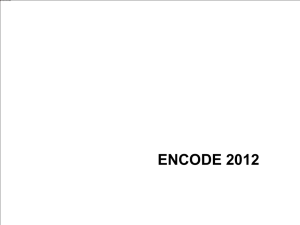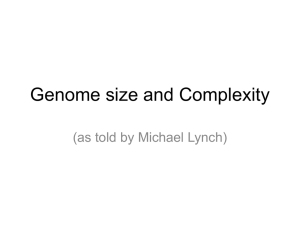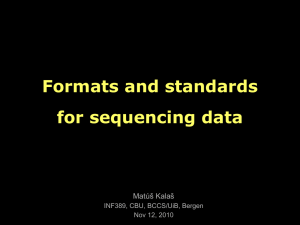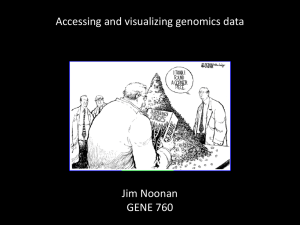MCB5472_lecture_3_26
advertisement
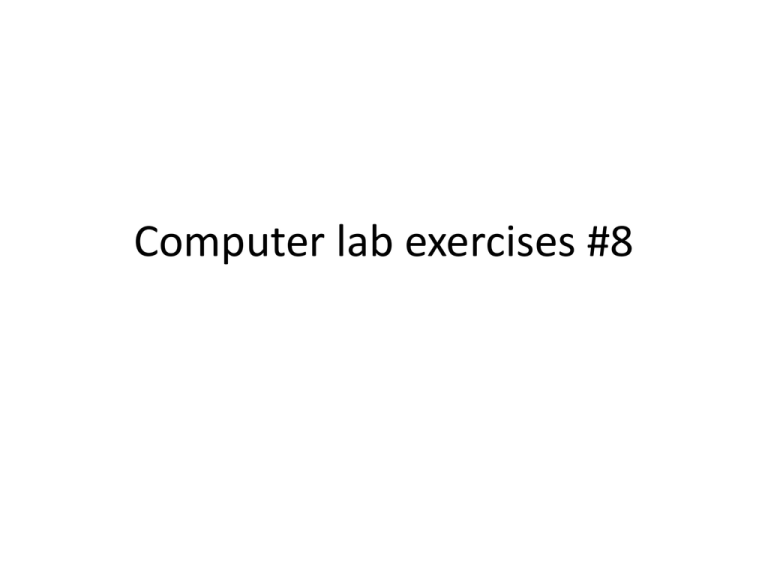
Computer lab exercises #8 Comments on projects worth sharing: 1. Use BLINK whenever possible. It can save a lot of waiting and greatly accelerates explorations. From a protein sequence entry in NCBI select “BLINK” under related information. (You might need to scroll down, in case the upper tables are expanded). BLINK provides a GUI interface to pre-computed BLASTP searches. ... If one is looking for homologs in other phyla or domains, Comments on projects worth sharing: 2. The Taxonomy Browser at NCBI can facilitate finding genome and EST projects. In entrez select taxonomy as databank Search for an organisms you are interested in, Select the group of organisms you are interested in Check genomes and ESTs and whatever else you like, THEN click display If you move up or down the taxonomic hierarchy, the checked items will be displayed for each Taxon or Retrieves all ESTs from Genbank You can select format or send to file to get a multiple sequence fasta file with all sequences You can select format or send to file to get a multiple sequence fasta file with all sequences Short in class exercise • Write and apply a script to calculate cumulative strand bias for a genome (fna file). In DNA replication the two strands are not created equal. See Drew Berry’s Ted talk at https://www.youtube.com/watch?v=WFCvkkDSfIU for illustration (start at 3 min – 4.50 min, if not much time) The differences between leading and lagging strand are reflected in the number or ORFs encoded on the strands and the presence of motifs that bind factors initiating and halting replication, and the composition with respect to nucleotides, and n-mers of nucleotides. One way to look at strand bias, is to calculate the GC content in a rolling window. Window=1000 , printed every 100 Window=10000 , printed every 100 Usually one plots the Cumulative Strand Bias to more clearly see the turning points Usually, *.fna files of bacterial genomes start with the origin of replication, and the direction is chosen so that the first encoded protein is DnaA (chromosomal replication initiator protein). Sometimes things go wrong. Cumulative Strand Bias HB27 Mummer Plot: HB27 versus SG0 Ori Should be here The same can be done with oligonucleotide bias (how often does an oligonucleotide occur on one strand minus occurrence on the other strand) Tetramer bias for Thermus thermophilus SG0 Download a bacterial or archaeal genome of your choice from ftp://ftp.ncbi.nih.gov/genomes/Bacteria/ We are only interested in the sequence of the main chromosome Write a script that 1. Reads in a genome 2. Assigns the nucleotides of the genome to an array (e.g. @genome) 3. Goes through the @genome array and sequentially counts the numbers of Gs Cs As and Ts 4. Every 1000 (or 5000) nucleotides calculate the excess of Gs over Cs, As over Ts, and the excess of keto bases (G+T-A-C). Feel free to explore other biases. 5. Print the results into a table 6. Plot the columns of the table in Excel or gnuplot Possibility for 1. Read in a genome The easiest will be to plagiarize a script you already wrote. The following works, if the script and the *.fna file are in the same directory. 1a: open input and output file, reset stuff Possibility for 1b: read genome into array You have 2 possibilities either read and analyze the genome line by line, or read in everything and then start the analysis. The $_ is the variable the perl goes through in the foreach loop, see P13 Possibility for 1b’: read genome into array You have 2 possibilities either read and analyze the genome line by line, or read in everything and then start the analysis. .... Write a script that 1. Reads in a genome 2. Assigns the nucleotides of the genome to an array (e.g. @bases) 3. Goes through the @bases array and sequentially counts the numbers of Gs Cs As and Ts 4. Every 1000 nucleotides calculates the excess of Gs over Cs, As over Ts, and the excess of keto bases (G+T-A-C). Feel free to explore other biases. 1. Print the results into a table Close loop(s), close files 6. Plot the columns of the table in Excel or gnuplot Links to info on gnuplot is here If gnuplot is installed on you computer and able to communicate with your x11 terminal program, then > gnuplot Will invoke the gnuplot program > plot "my_table" using 1:2 with lines will plot the 2nd columns against the 1st >set terminal x11 Will set the output to x11 (screen) >set terminal png Will set the output to a png file >set terminal postscript sets the output to a postscript file > set out "myplot.png” directs output to the file myplot.png > set multiplot Plots multiple curves into the same figure > plot "my_table" using 1:4 with lines,\ > "my_table" using 1:2 with lines,\ > "my_table" using 1:3 with lines plots multiple curves onto the same figure. gnuplot is installed on the cluster, but you need to direct the output to a file, which is inconvenient (extra credit, if you can make the cluster output to an x11-window on your laptop) Often one uses a perl script to do the plotting example here

